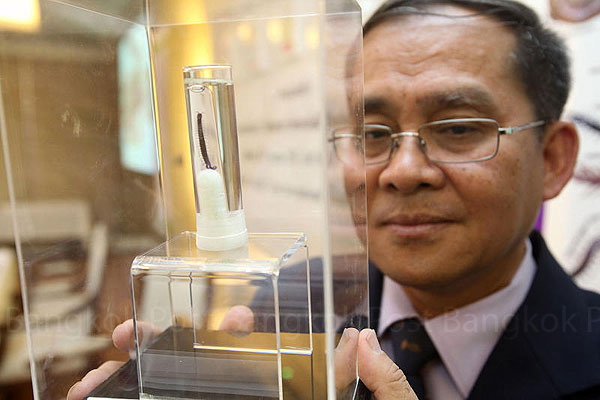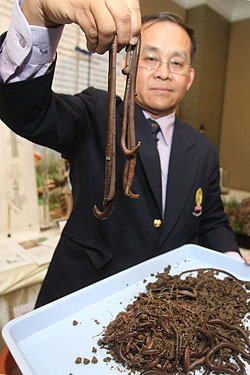
Photos courtesy of Bangkok Post
Local biologists recently discovered 35 new species of earthworms, mostly in the northeast of Thailand.
Read the following story from the Bangkok Post to learn more about these scientific discoveries.
After five years of research, is was revealed on October 7 that biologists at Chulalongkorn University have discovered 35 new species of earthworms, one new centipede and a new species of leech.
Lead researcher Somsak Panha, Associate Dean of Research Affairs in the biology department, said most of the new earthworms were discovered in the Issan region.

NEW DISCOVERIES
Twenty species are giant earthworms measuring 30 to 40 centimetres long, which is 20 times bigger than ordinary earthworms found elsewhere in the country. Most of them were found in Surin, Kalasin and Chaiyaphum.
The other 15 new earthworm species live in a unique biological system of fresh water. These include earthworms from the Pachee River basin, Kaengsapher creek in Ubon Ratchathani and from Phuket province.
“Different kinds of earthworms have different functions to fertilise soil,” Somsak said. “If we know more about them, we can gain more knowledge in developing agricultural zones to make them more fertile so that we can depend less on fertilisers and pesticides.”
WORM WORK
Details of the discovery have been published in ZooKeys, an EU-based online biological journal, and in Raffles Bulletin of Zoology, another biological journal published by Singapore’s Lee Kong Chian Natural History Museum.
Somsak and his team discovered the earthworms during five years of studying subterranean species. He has now earned the distinction of being the top discoverer of earthworms in Asia.
UNIQUE CENTIPEDE
In 2011, Somsak’s team found a new species of centipede at Similan Marine National Park in Phangnga province while working on a project to conserve plant genes, hosted by Her Royal Highness Princess Maha Chakri Sirindhorn. The princess later named the species Sterropristes Violaceus Muadsub and Panha. The word violaceus means purple, which is the princess’s birthday colour. The centipede’s tail and head are a deep purple colour, and it measures about 5 centimetres in length.
The centipede evolved uniquely because the island where it lives was cut off from the mainland several thousand years ago. It has become living evidence of how geological change can determine an animal’s evolution.
Exercises
Read the story. Then, decide whether the following statements are true or false.
1. Violaceus means red.
……………….
2. Most of the news species of earthworms were found in the south of Thailand.
……………….
3. Of the 35 new species of earthworms, 20 are giant earthworms.
……………….
4. Somsak’s team took five years to complete their research.
……………….
Vocabulary
- earthworm (n): a common long thin worm that lives in soil
centipede (n): a small creature like an insect, with a long thin body and many legs
fertilise (v): to add a substance to soil to make plants grow more successfully
pesticide (n): a chemical used for killing pests, especially insects
subterranean (adj): under the ground
geological (adj): connected with the scientific study of the earth, including the origin and history of rocks, soil, etc.


